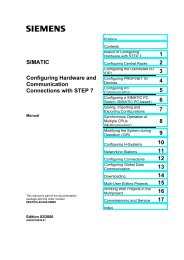II - DCE FEL ČVUT v Praze
II - DCE FEL ČVUT v Praze
II - DCE FEL ČVUT v Praze
You also want an ePaper? Increase the reach of your titles
YUMPU automatically turns print PDFs into web optimized ePapers that Google loves.
3.1.2 Analog Representation for Measuring Ranges of Analog Inputs<br />
Introduction<br />
How to read the<br />
measured value<br />
tables<br />
Measured value<br />
resolution<br />
I/O Modules with Intrinsically-Safe Signals<br />
C79000-G7076-C152-04<br />
The tables in this section indicate the digitized analog values for the effective<br />
measuring ranges of analog modules.<br />
Tables 3-3 to 3-19 list the digitized analog values for different effective<br />
measuring ranges.<br />
Since the binary representation of analog values is always the same, these<br />
tables contain only a comparison of the measuring ranges with respect to the<br />
relevant units.<br />
Deviating from this, a Sigma-Delta AD-converter is used with the analog<br />
input modules described in the manual. Irrespective of the configurable<br />
integration time, this converter always makes available the maximum<br />
representable 15 Bit +sign. Lower resolution ratings than indicated in the<br />
specifica- tions are due to conversion noise based on the shorter integration<br />
times (2.5, 162 /3, 20 ms). The different integration times change nothing with<br />
regard to numerical representation of the measured values. The number of<br />
stable bits is specified in the technical specifications.<br />
The number of stable bits is the resolution, at which, despite noise, the<br />
”no missing code”-characteristics of the AD-converter are guaranteed.<br />
The bits which are no longer stable at shorter integration times are marked<br />
with ”x” in the following tables.<br />
Table 3-2 Representation of the smallest stable unit of the analog value<br />
Stable bbits ts<br />
Smallest stable unit Analog value<br />
(+ sign) Decimal Hexadecimal High-Byte Low-Byte<br />
9 64 40H Sign 0 0 0 0 0 0 0 0 1 x x x x x x<br />
10 32 20H Sign 0 0 0 0 0 0 0 0 0 1 x x x x x<br />
12 8 8H Sign 0 0 0 0 0 0 0 0 0 0 0 1 x x x<br />
13 4 4H Sign 0 0 0 0 0 0 0 0 0 0 0 0 1 x x<br />
15 1 1H Sign 0 0 0 0 0 0 0 0 0 0 0 0 0 0 1<br />
What can you do<br />
with the<br />
noise-prone bits<br />
SIMATIC S7 Ex Analog Modules<br />
At a constant input voltage, noise causes distribution of the supplied value by<br />
more than 1 digit. In the majority of cases, these ”unsteady” values can be<br />
used as they are. In any case, this is the most effective option when<br />
subsequent processing has integral action characteristics (integrator,<br />
controller, etc.) in any form whatsoever. If this unsteady state is undesirable<br />
(e.g. for display/indication), you can<br />
mask out the ”x” bits<br />
round up to ”stable” bits<br />
filter the successive values<br />
3-3
















